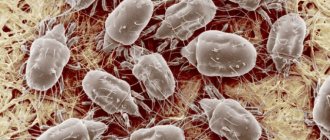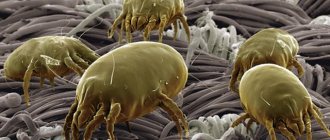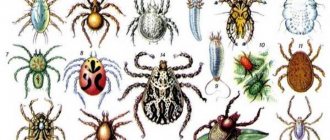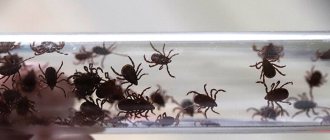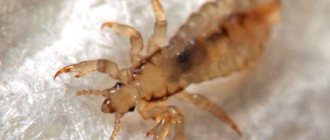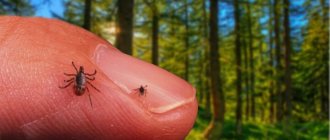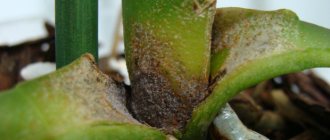Description of pest varieties and photos
The following types of mites can infect an orchid:
- Root. This is a small spider, which has 3 pairs of legs, sharp mustache, and a large oval-shaped body. The parasite is characterized by high endurance, due to which it can remain without food for a long time. It feeds on underground plant elements and organic remains.
- False arachnoid. This parasite is 0.25-0.3 mm in size. It is simply impossible to see it with the human eye. The color of the body is from greenish to red. The mite does not weave a web, so it will be possible to see it on an orchid only after the colony has grown.
- Red spider mite. This parasite does not die from drugs that are designed to combat them. The color of his body can be red, orange and yellow.
- Bulbous. This tick is small and slow moving. Its length reaches 0.3-0.6 mm, its color is brown, its limbs are spherical in shape, and its jaws are brown.
- Flat-bodied. This is a small parasite, as its size does not exceed 0.3 mm. The body is oval in shape, highly flattened, yellow-red in color. All bristles located on the body are also short.
- Armored. These are arachnid pests that live in the soil and feed on dying elements of the orchid.
Below you can see photos of the varieties.
Red spider mite.
Use of chemicals
Using insecticides is the best way to control mites.
It is necessary to treat indoor orchids after preliminary preparation:
- clearly visible lesions are trimmed;
- the cut areas are sprinkled with crushed activated carbon or cinnamon powder;
- the substrate from the pot is disposed of;
- the pot container is disinfected with a highly concentrated solution of potassium permanganate.
To avoid pests becoming accustomed to any active substance, the drugs should be alternated.
The treated orchid is planted in a new substrate and isolated from other plants for 2-3 weeks or until the insect is completely destroyed.
Fitoverm
Biological insecticide of the contact-intestinal spectrum, based on the activity of soil fungi that are destructive to some types of pests.
The main active substance is aversecticin-C, which has paralytic properties. Penetrates through the skin and gastrointestinal tract. Detrimental to adults, but not effective against larvae and oviposition.
Suitable for spraying on vegetative mass and immersing roots. It is necessary to carry out 3-5 treatments at weekly intervals. If there is no result after the second procedure, Fitoverm is replaced with a stronger drug.
Aktellik
Organophosphorus complex of contact-intestinal action.
It is highly toxic, belongs to class 2 of hazardous toxic chemicals, can be used outdoors or with mandatory room ventilation.
The main active substance is pirimiphos-methyl. The systemic drug is able to combat different types of pests. It has a detrimental effect on adults, but is ineffective against eggs and larvae. It is distinguished by its relative speed, leading to positive results after the first treatment after 1 week.
Maintains effectiveness within 15-25°C. Apply up to 5 times with an interval of 7-10 days.
Neoron
A strong contact insectoacaricide that causes instant death of pests. The main active substance is bromopropylate.
It has long-lasting activity, providing reliable protection for 30-40 days at any temperature. Does not penetrate plant tissue, acts superficially.
Suitable for use against adult insects, larvae and oviposition. There is no resistance. Toxic. If the affected area is small, the concentration must be reduced.
Thiophos
After treatment, the plant must be replanted
An oil-based organophosphorus insecticide with a garlicky odor that repels ticks. The main active ingredient is parathion.
Apply once in case of extensive infection, because highly toxic. Used primarily on an industrial scale.
Step-by-step instructions on how to get rid of various pests
Arachnoid
After detecting a spider mite on an orchid, you can get rid of it using several methods:
- Biological. It is enough to have several walls of predatory beetles that will destroy adult ticks.
- Chemical. Insecticidal preparations need to be alternated, as parasites develop immunity to the products used. In addition, a one-time treatment will not be enough; it will have to be carried out systematically. The following drugs are effective: Metaldehyde, Thiophos, Actellik.
- Folk. To combat spider mites, you can use a decoction of cyclamen roots. Pour water over the tubers, boil for 30 minutes, leave for 24 hours, and use the resulting filtered liquid to spray the orchid. Carry out treatment every 5 days 3-4 times. Simply wiping the orchid leaves with a cloth soaked in alcohol will help get rid of spider mites.
We invite you to watch a video on how to get rid of spider mites:
Bulbous
As soon as this pest is discovered, it is necessary to immediately change the soil in the pot. You can get rid of bulb mite in the following ways:
- Folk. Using folk remedies is effective only at the early stage of the infection, when the mites have not spread much. A solution of laundry soap is suitable (20 g of raw materials per 1 liter of water). You can use it to wipe orchids or immerse the flower completely in the solution. You can try spraying the plant with a weak solution of potassium permanganate.
- Chemical. Flower growers use general-spectrum insecticides. But you can also use highly specialized drugs that will only fight ticks - these are acaricides. To prepare the solution, you need to use the instructions indicated on the package.
The concentration can be made weaker, but not stronger, otherwise the opposite effect is possible. It is necessary to soak the flower in the prepared solution, and send the roots back into the soil only when they are completely dry.
Root
This parasite is the most difficult and tenacious to remove. It has a high ability to recover and reproduce. If a root mite is noticeable on the orchid, then all affected parts of the flower must be urgently removed, and the cut areas must be treated with activated carbon powder. Affected plants must be isolated from other healthy ones. Throw away the soil immediately and disinfect the pot.
To prepare the solution, you need to: take 700 g of fresh herb, pour 5 liters of boiling water and leave for 30 minutes in a dark place.
How to treat a plant? This is done within 5 minutes, immersing the entire orchid in the broth. Of the chemical preparations, ascaricides remain effective. You can also use the insectoacaricidal agent Acaritox against pests. Use it strictly according to the instructions, and the frequency of treatment is every 5-7 days.
What parts of the flower may be affected?
Mites can attack leaf blades, flower stalks, and the buds themselves. You can also find them in soil mixtures. However, some species of these animals cannot be seen without a magnifying glass.
What do the affected areas look like?
Very small gray blotches appear on the green part of the plant. The leaves also begin to change their shape and dry out at the edges. When the infection reaches a high concentration, a web will appear on the orchid. Too short peduncles and deformed flowers are also the work of mites. Plus, a purulent process begins at the growing points of the orchid.
In some areas, a metallic sheen appears due to the fact that the bite site fills with air and swells slightly. If this shine is not present, then the bites can be recognized by the depressions formed - in these places the ticks have sucked out the juice and made them lifeless.
In the photo you can see what mites and their bites on orchids look like:
Firstly, if you find this type of mite, immediately change the soil in the flowerpot.
- Folk remedies. Suitable only for those stages when ticks have not yet spread much. Sometimes it can be more of a preventive measure than a curative measure. A solution of laundry soap is suitable for this, which can be used to either wipe the surface of the orchids or immerse it completely in it. After this, do not forget to rinse the plant.
A manganese solution is considered a little stronger (but it should not be saturated, but on the contrary, slightly pinkish in color). Treat it in the same way as with soap. Chemical preparations. Insecticides are recommended for general use. But we will advise you to purchase products of a more narrow specialization, the action of which is aimed specifically at combating ticks - these are acaricides.
You will need to dilute the product, while strictly following the directions on the package. You can make the concentration weaker, but in no case stronger. Otherwise, the effect will be the opposite - you will simply destroy the flower.
Take the orchid into the soil and soak it in the resulting solution (the soaking time is also indicated in the instructions). You only need to send the roots back into the ground when they are completely dry.
Root
If you notice a root mite on an orchid, immediately remove the affected areas of the flower. (Don't forget to treat the cutting areas.) Isolate the infected plant from other healthy ones. Immediately discard the soil and disinfect the flowerpot.
- Among folk remedies, you can choose a nettle tincture, which, in addition to everything else, will also raise the level of immunity. To prepare this miracle potion, take 700 grams of fresh herbs, pour five liters of boiling water and leave to infuse in a dark place. This process can take up to five, so make sure you always have this tincture in stock.
- As for chemicals, ascaricides are again needed. The insectoacaricidal agent acaritox is suitable for pests. It must be used according to the instructions. Remember to repeat the procedure after five to seven days.
- Biological products can also be used. They are also excellent at fighting ticks, but at the same time they have a natural base, such as oils.
Flat
If you want to immediately take on the heavy artillery and fight the flatworm with chemicals, then turn again to acaricides. Remember that mites are not insects, so insecticides will not help you.
Please note that any drug is toxic, so you need to handle it with extreme caution. But there are several that are considered most suitable for use in enclosed spaces: Actofik, Fitoverm, Vermitek
Repeated treatment will be necessary, because no product kills eggs and larvae.
Folk remedies can be used the same as for “war” with other types of ticks. But do not forget that they are effective only in the early stages of infection.
Disease prevention
To prevent mites from appearing on orchids, the following preventive measures must be observed:
- Periodically dry the soil in which the flower grows.
- Spray the flower in a timely manner and ensure that drops of liquid do not stagnate in the axils of the leaves. Otherwise, the orchid will rot.
- Maintain the optimal watering regime.
- Ticks appear in rooms with dry air. You can increase the humidity by placing a container of water at room temperature near the orchid for 2 days. The water will evaporate and the air will become humidified.
Caring for an orchid is very difficult, especially when it comes to pest control. The difficulty is that the flower is attacked by small parasites such as mites. It is not always possible to see them immediately and eliminate them in a timely manner, so you have to resort to more aggressive methods of control when the accumulation of pests is already massive.
If you find an error, please select a piece of text and press Ctrl+Enter.
Experienced farmers know well that the appearance of mites on an orchid is a very common occurrence. There can be many reasons for this - improper care of the plant, changes in temperature and humidity, and lack of fertilizing. To get rid of a dangerous pest, you should know and be able to use certain methods and technologies.
Prevention of infection
Knowing how to get rid of a pest, you also need to understand how to carry out prevention. For prevention purposes, it is recommended to regularly spray the leaves and maintain normal indoor humidity. An alternative to water spraying is to place the pot in a basin for 3 minutes (the water should cover the plant). During this time, all pests will crawl out. But frequent water procedures are prohibited due to the risk of rotting processes. The optimal number is 1-2 times a month.
Other preventive measures include treatment once a month with a weak solution of biological preparations, timely removal of fallen leaves, and maintaining the same temperature.
It will be useful for gardeners to learn on our website about other orchid pests: bugs, including white bugs, thrips, scale insects, midges, mealybugs and aphids.
The orchid is a capricious, but surprisingly beautiful plant. You can achieve colorful flowering and healthy bushes with proper and high-quality care. To prevent mite infection, it is necessary to regularly spray the orchid with water or weak biological solutions. To combat the parasite, you should use chemicals, folk recipes or biological agents.
Description of pests
Orchids are one of the most beautiful flowers in the world, but these delicate plants are often attacked by various parasites. There are certain prerequisites for the development of such negative phenomena.
Entomologists say that a tick is not an insect, but an arthropod. The peculiarity of these creatures is their phenomenal survival rate in a wide variety of conditions. The difficulty is that the false spider mite is microscopic in size and it is extremely difficult to see it on flowers. Its parameters do not exceed half a millimeter, and the color of the body depends on the color of the plant it eats. The chitinous cover of these insects can be red or green.
Adult mites have eight legs, but their movement throughout the plant is extremely leisurely. While eating an orchid, the mite simultaneously weaves a web that envelops the stems and buds of the plant. If there is a cobweb, this means that new generations of pests will be born in the near future.
This parasite is dangerous because it multiplies exponentially. In just 2-3 weeks, the larva turns into an adult. This creature lives no more than 40 days, but this is enough for it to destroy the plant. The favorite delicacy of such insects is plant juices: the mite bites through the epidermis of the orchid and injects it with a special enzyme that dissolves the cells. A nutritious biomass appears, which the parasite sucks out.
At the site of the lesion, yellowness, white plaque, and cobwebs form, and after a short time this area dies. If the finest cobwebs appear on the flowers and buds of an orchid, this indicates that there are many parasites on the plant; urgent measures must be taken to eliminate them. Various parasites additionally penetrate into areas affected by ticks:
If you do nothing, the plant will quickly become covered with dark (sometimes black) spots. When such a phenomenon occurs, the orchid is practically doomed.
Generations of mites live in large numbers in fertile soil; they can be seen with a magnifying glass. The following types of mites “love” the orchid.
- Root. This parasite has 6 legs, a mustache and a body shaped like an elongated oval. It has good resistance and can go without food for several months. A favorite delicacy is the root system of various plants.
- Red spider mite. One of the most common. Tolerates poisonous drugs well. The color of the calf can be yellow and even bright orange.
- Bulbous. It has a size of no more than 0.5 mm, and this parasite is extremely clumsy. The color is dark brown, the body is oval. There are short bristles on the body.
- Armored mite. Looks like a spider and feeds on plant roots.
There are also a number of parasites that are very harmful to orchids.
- Thrips. These are gray flies that appear due to overdrying of the plant. Thrips feed on sap, so the flower dies within a week or two.
- Mealybugs. They manifest themselves with a white coating that looks like frost. They also feed on flower juice, representing a medium degree of danger.
- Shield. These are flies that are covered with a dense black shell. When an insect is in the larval stage, it is not easy to detect it; you need to use a magnifying glass.
- Common aphid. Appears on many plants. The insect is very fond of young leaves and flower petals. Due to their size, aphids are clearly visible on the leaves.
- Fools. These are microscopic beetles that live in the substrate and are very fond of the root system. They reproduce if there is low temperature and abundant watering.
Prevention
Every time you bring a new orchid into your home, quarantine it for 10-20 days. But before isolating, the plant needs to be thoroughly rinsed in the shower, and then the flowerpot with the flower should be kept in a basin of water for about thirty minutes. This time will be enough for all pests, if any, to emerge from the soil.
During replanting, keep the new soil in the freezer or in the microwave. This will remove all parasites. And, of course, do not forget about regular hygiene of any plant: wiping the leaves, spraying.
Naturally, ticks will not bring any joy, so try not to let them appear. Follow the instructions for proper care of orchids, and then your beauty will not be overtaken by any pest.
Reasons for appearance
Infection of orchids by mites occurs through the air. Strong winds can carry the larvae of these creatures for many kilometers. In hot, windy weather, the most fertile time comes for ticks to “travel” through nearby surroundings. During the incubation period, humidity is also important - if it is 28-42%, then the parasite will multiply rapidly. As humidity decreases, the development of spider mites slows down.
Spider mites appear on the orchid when there is minimal humidity in the air, this is what provokes the active development of the pest. Mites can completely destroy many house plants in a few days or transform them beyond recognition.
To effectively stop the threat, you need to understand why the parasite appeared. Often, a similar phenomenon occurs when farmers buy seedlings in a store or exchange young plants with each other. Knowing the cause of the orchid disease, it will be easier to eliminate its consequences.
Harm from ticks
The pest can destroy the flower
The danger of ticks lies in their active reproduction. Each female is capable of laying up to 200 eggs. In just 2-3 weeks, a parasitic insect develops from a larva to an adult fertile individual.
It feeds on plant juices, biting through the upper layer of the epidermis and introducing a special enzyme that decomposes the cell structure. As a result, elastic tissues turn into destroyed biomass.
The affected areas become open to the penetration of pathogenic microorganisms and fungi.
If the pest is not completely destroyed in unfavorable conditions for it, the insect in the larval stage enters a state of diapause, stopping development for a period of up to 5 years, completely restoring vital activity with a change in microclimate to a suitable one.
How to deal with them?
To get rid of spider mites and other types of mites at home, you should take a number of effective measures. First of all, it is necessary to disinfect the affected area. You should use diluted laundry soap: one large spoon of liquid soap is mixed in one liter of water. Using a cloth or sponge, gently wipe the surface of the plant.
It is important that the soap solution does not get on the ground, otherwise the root system will be damaged. The tray and pot should be wiped with a disinfectant solution, and if the orchid is on the windowsill, then it is also advisable to wipe all the surfaces around with a soap solution.
After this, you should pour the substrate, cover the plant with a transparent film, and keep it in this form for at least 70 hours. The film increases the percentage of humidity, which promotes the active annihilation of insects and can cure the plant. It is important to remember that the orchid is afraid of direct sunlight; the flower should be kept in the shade.
Pests on indoor plants are always a nuisance and additional trouble for the gardener. Spider mites on an orchid are a special problem, because the pest arthropod is very small in size, and it is very difficult to notice it without a magnifying glass. Sometimes it becomes clear about the presence of ticks after a significant increase in the colony of parasites, forming up to 20 generations per season under favorable conditions.
How to deal with spider mites on orchids
Orchids are distinguished by the fact that they cannot be soaked for a long time in any solution; sometimes water should not be allowed to enter or remain in the axils of the leaves. Very often, after treatment for mites, orchids develop rot - from waterlogging of the soil, leaves, and root zone. But, oddly enough, orchids are resistant to chemicals, phytotoxicity is not expressed. Therefore, if you fight mites on orchids, then develop a method that allows you to get rid of the pests in one go. The easiest way is to prepare an acaricide solution and completely immerse the orchid in it along with the block or pot for 2-3 minutes. Then let the solution drain, thoroughly dry all the axils of the leaves using a piece of toilet paper folded into a cone (it absorbs moisture better than cotton swabs). If the orchid is in the bark, the pot may smell for a while. Don't rush to wash the bark; mites could be hiding inside. Place the orchid in a place where there are no drafts (even a window in the warm season). During the next watering, add phytosporin-m to the water: 5 g of powder per 500 ml of water.
Orchids tolerate mite treatment well with such agents as Actellik, Neoron, Apollo, Envidor, and Ortus. These products are most effective, unlike other acaricides (fitoverm).
What does a spider mite look like?
In the family Spider mites (Tetranychidae) there are up to 1270 species of arthropods in 95 genera, distributed everywhere, with the exception of the harsh Antarctic. Representatives of about 35 genera parasitize orchids, but several are especially common.
Herbivorous mites feed on cell sap and actually lead to the death of the affected flower. They have microscopic sizes - their oval bodies do not exceed 1 mm in length. Depending on the species, the color can vary - whitish, dirty yellow, reddish brick or orange; in some species two dark spots are clearly visible on the back. The mouthparts are piercing-sucking type. Each of the four pairs of legs consists of five segments.
During their development, spider mites go through five stages:
- eggs, as a rule, are round, about 0.15 mm in diameter, white or orange-red in color, laid on the underside of the leaf blade and covered with a characteristic thin silvery cobweb;
- white or red larvae;
- two nymph stages, often yellow-greenish in color;
- imago, or adult individuals.
In addition to causing harm to plants - sucking juices, mites also transmit pathogens of many viral infections, as well as a dangerous disease of orchids - gray rot.
How to recognize
It is very difficult to visually detect an individual individual due to its small size. This can be done by careful examination using a magnifying glass or under a microscope. More often, gardeners become aware of the presence of an insect when there are already large clusters. Usually the pest settles on the underside of leaves.
When you press firmly on the white webs, a reddish liquid appears - the result of crushed oviposition.
In places where the tick appears, yellow spots, a white powdery coating that looks like a fungal disease, and white cobwebs form.
In advanced cases, the spotting becomes black. After a certain period, the affected area of the plant dries out and dies, leaving behind depressions and holes.
Types of mites that parasitize orchids
In addition to spider mites, flat beetles or false spider mites are found on orchids, which do not weave webs and reproduce in other environmental conditions. It is quite obvious that you can choose the right way to combat arthropods only by understanding and correctly identifying the species that has settled on the orchid.
After all, some mites prefer dry air and high temperatures, while others, on the contrary, develop normally and give birth to offspring in conditions of high humidity in the room with relatively low thermometer readings.
The most common types of spider mites found on orchids are:
- Common (Tetranychus urticae) - soft-bodied arthropods with a convex upper and flat lower body, 0.4–0.6 mm long in females and 0.3–0.45 mm in males. The larvae have three pairs of legs, transparent, pale greenish to greenish-brown in color with two dark spots on the sides. Adult wintering females acquire an orange-reddish color in early autumn and already have 8 legs.
- Carmine (Tetranychus cinnabarinus) - adults are dark red or burgundy brown with an ellipsoid body. The larvae and eggs are reddish, and the nymphs are yellow-light green.
- Turkestan tick (Tetranychus turkestani) - in size and anatomical structure does not differ from the common tick, the color of the body is yellow-green, in wintering females it is bright red in autumn and early spring.
Flat mites differ from spider mites anatomically: their body is dissected by transverse sutures into parts - anterior, posterior and middle. As a rule, the following types of flat beetles or false spider mites settle on orchids more often than others:
- Phalaenopsis flat mite or phalaenopsis flat mite (Tenuipalpus pacificus) was first described on phalaenopsis, but, despite its name, parasitizes many species of orchids. An extremely small pest - the reddish body of the female barely exceeds 0.3 mm, and the male usually reaches no more than 0.25–0.27 mm. It differs from the greenhouse beetle in the presence of two antennal-like setae on the back of the abdomen. The eggs are red, oblong, the larvae are the same color, six-legged. A very secretive arthropod, compared to its other relatives, on an orchid it hides in shaded places that it rarely leaves - in the folds of foliage, at the base of the stem and young roots, in the axils of leaf blades.
- The greenhouse beetle (Brevipalpus obovatus) is a terracotta-red arthropod with an ovoid body covered with a mesh pattern on the back. Both eggs, larvae, and nymphs are colored in various red shades, which is why it is often called red flat mite among orchid growers.
- Oncidium flat mite (Brevipalpus oncidii) is a small arachnid with an oval orange-red body up to 0.3 mm long. Their eggs are also reddish. In addition to direct damage to leaf tissue, it injects toxic saliva into plant cells.
The root onion mite or onion mite (Rhizoglyphus echinopus) is also found on orchids - elliptical arthropods of white or light yellow color with strong brownish legs. It is practically inaccessible to view, since it parasitizes on the roots and at the base of the stems.
Types of parasites - signs of appearance on plants
Representatives of many species of mites that live on orchids are characterized by small sizes. This makes them difficult to find. But you can navigate by the external signs of plants during the period of arthropod parasitism. Representatives of each species most often leave characteristic marks, but nonspecific manifestations that are common to different pests may also occur.
Root
These ticks got their name from the environment in which they live. Thus, they prefer to colonize the root system of plants. Orchids are one of the favorite flowers of such parasites. The main signs of their appearance:
- violation of pigmentation, which leads to a change in the color of individual sections of the leaves;
- change in the shape of the above-ground parts of the plant;
- the primordia of peduncles are deformed;
- the orchid stops developing;
- mold on the bulbs, they change shape and lose their elasticity.
External signs of the ground parts of flowers are nonspecific - they can occur with the appearance of various parasites.
Type of root mite.
False arachnoid
Such individuals are much smaller than true spider parasites - the body length is 0.25 mm. The color can also be red, but pests do not leave cobwebs on orchids. Pests of this species are distinguished by their slowness. To remove ticks, you need to understand how the infestation manifests itself:
- reddish dots are found on the leaves (on the back side);
- the plant withers;
- the leaves begin to dry out and soon fall off;
- the buds do not develop and also fall off.
Compared to a real spider mite, a false spider mite does not leave marks on the plant.
Red spider mite
The parasite is slightly smaller (body length of females - 0.4 mm, males - 0.35 mm). Such individuals prefer to live in warm climates (air temperature +30°C). The main signs of appearance on an orchid:
- white dots on the leaves – tick bites;
- wilting of the plant;
- is found not only on the back of the leaves, but also on the top;
- the web appears in areas - at the point of leaf growth.
Red spider mites live in warm climates.
Bulbous
Based on the name, it can be assumed that such individuals infect plant bulbs. They are characterized by their short length (0.25 mm) and pale pink color. The fight against such pests should begin when signs are detected:
- spots of a different color on the bulbs;
- the plant does not develop;
- the shape of the leaves changes;
- you can notice brown tissue on the leaves and flowers;
- secondary infection occurs - fungi, bacteria.
The bulb mite attacks the roots of plants.
Flat-bodied
The body length is no more than 0.3 mm, which makes it impossible to detect the pest. Staying motionless on the plant also makes it difficult to notice mites of this species. The main symptom is the appearance of numerous punctures on the leaves. They look like a silvery coating on the grooves.
Flat-bodied mite on orchid leaves.
Armored
Such individuals are more often found on phalaenopsis orchids. They are characterized by a dark color and are larger than their considered counterparts, which simplifies the search. They live in the ground, feed on organic debris, and when there is a lack of food, they move to the ground parts of plants.
Orchid mites are found on an orchid of this species (phalaenopsis) due to the lack of need to dry the substrate, because they can only live in conditions of high humidity.
Armored mites are characterized by a dark black color.
Optimal conditions for the appearance of mites on orchids
Spider mites prefer dry air and high temperatures, so they attack weakened plants kept in such conditions. They reproduce in closed ground when the thermometer is not lower than 12 degrees Celsius. About 20 generations are produced annually, the full development cycle of one generation lasts from 12 to 20 days, and it decreases with increasing air temperature. The optimal range is 28–32 degrees above zero with air humidity no more than 45–50%, when the complete transformation into an adult spider mite occurs in 6–6.5 days.
Favorable conditions for pests
- Arachnoid. For them, favorable conditions in which they can live and reproduce unhindered are warm and dry air. The reproduction process occurs in the ground when the temperature does not drop below 12°C. Under favorable conditions, they are capable of producing about 20 new generations. The development cycle takes 12-20 days; the higher the temperature, the less time is required. When the temperature is 28-32°C and the humidity is kept within 45%, the process of development to an adult takes only 6 days.
- Flat beetles. These individuals are absolutely not capricious and do not require any special conditions for reproduction. Reproduction occurs indoors all year round. If by increasing humidity it is possible to create conditions for spider mites that will slow down their development, then in this case this method will not bring results.
- Bulbous. Their life cycle is completely dependent on temperature; they prefer warmth and when the temperature drops, development slows down significantly. For example, if at a temperature of 16-28°C it takes about 10 days to develop, then when the temperature drops to 20°C this process will take more than two weeks.
Symptoms of mite damage to orchids
It is difficult to visually detect the presence of arthropods without an optical instrument due to their microscopic size. A characteristic sign of spider mites settling on flowers is the appearance of silvery cobwebs on the underside of leaf blades. If you press it lightly with some object, a reddish liquid substance from crushed eggs will form.
With flat beetles it is even more difficult - their presence becomes obvious when the colony has already significantly increased in number. However, an experienced orchid grower, having looked closely, will notice small white spots on the leaf blades, as if from injections with the finest needle - this is the death of the leaf tissue in the places of the bites.
Over time, the dots merge into large spots, which then turn brown, and the leaf finally dies. It is quite possible to see the same punctures at the base of the stem, in the axils of the leaves; the main thing is to carefully examine your orchids so as not to miss the time, after which it is no longer possible to try to save the plant.
Conditions of appearance and signs of damage
On phalaenopsis, root mites will multiply quickly when:
- dry air;
- high temperature;
- provided that the plant has a weakened immune system.
Experts have found that the spider feels comfortable when:
- temperature +28+32C;
- humidity less than 50%.
Flat-bodied ticks can develop in closed ground throughout the year, and they do not require special conditions. High humidity can only slow down the transformation of a small individual into an adult, but this process is inevitable.
Important! To prevent the plant from becoming infected with pests, it is forbidden to use contaminated planting substrate taken from the garden bed. Even if there is a need to use such soil, it needs to be prepared and processed. Mites on an orchid are located to feed on the juices of the flower
This occurs by piercing the surface of the foliage or stems, through which the pest introduces a substance that can destroy the cell membrane. This helps accelerate the secretion of juice and its release through the affected area, through which the spider feeds
Mites on an orchid are located to feed on the juices of the flower. This occurs by piercing the surface of the foliage or stems, through which the pest introduces a substance that can destroy the cell membrane. This helps to accelerate the secretion of juice and its release through the affected area, through which the spider feeds.
Through the hole made, air penetrates into the structure, and this leads to the transformation of green foliage into silver, it becomes covered with cobwebs. Soon the leaves will turn yellow, and the affected areas will quickly spread throughout the plant, causing them to fall off.
In some cases, cobwebs can be found not only on the foliage, but also on the surface of the buds. This is a sign of the presence of a large spider colonization, and if the orchid is not treated for mites, it will die. What will happen:
- gradual yellowing;
- curling the tips of the leaves;
- drying out;
- death of leaves and buds.
If the orchid is not treated, mites can cause a bacterial, viral or fungal disease, as evidenced by the presence of dark spots and weeping areas.
Symptoms of mite damage to orchids
Insect control measures should be chosen depending on the signs of the presence of a spider. It is too difficult for inexperienced gardeners to detect arthropods, especially without using optical instruments. Education can be considered a characteristic feature:
- Cobwebs are silvery or white on the underside of the leaves, which, when pressed, acquire a reddish tint and transform into a liquid substance.
- Small white spots on the surface of the leaf blade, which look like many injections made with a thin needle, which leads to the death of the affected tissue.
Note. Over time, the dots merge into spots of a brown tint, which is why the green areas die off
Injections can be seen in the area of the leaf axil; you need to regularly inspect the plant.
How to inspect a plant
The fight against spider mites on orchids begins with a thorough examination of the flower to detect parasites. They look different, and therefore it is worth studying all their forms
Since it is almost impossible to examine the spider, you need to pay attention to the following points:
- accumulation of insects on the back of the foliage;
- sudden decline for no reason;
- formation of large and white spots;
- white cobwebs throughout the plant;
- twisted and dried leaves.
Do not confuse black and white spots, as the former are a sign of fungus and mold. Having eliminated the fungus, you should not assume that the problem is solved, since the immune system is weakened and the colonies will begin to actively grow further. Parasites prefer young and succulent foliage, and therefore it is young plants that die.
Ways to combat ticks
Experienced orchid growers advise that immediately after discovering uninvited guests, isolate the affected plant in a separate room, away from the entire collection of orchids, for which the air humidity is increased if you are completely sure that they are affected by spider mites and not by another type of mite.
First of all, the flower must be washed with soapy water to remove those individuals that have not yet had time to attach themselves to the leaf tissues. Many gardeners wipe the leaves of orchids with a cotton swab dipped in alcohol, but for plants with thin-skinned leaf blades and young specimens with delicate foliage, such an action is not suitable - it can result in a burn from the alcohol.
Next, a method of destroying parasites is selected depending on their number on the flower - in case of small damage, gentle folk recipes can be a salvation; in case of numerous colonies, chemical preparations are used immediately as they are more effective.
Folk remedies
To combat mites on indoor flowers, folk methods of combating the parasite are used - decoctions and infusions of insecticidal plants:
- Decoction of cyclamen tubers. Cyclamen tubers are cut into pieces and boiled in boiling water for about 40 minutes, then left for a day and filtered. Spray orchids at intervals of 5 days.
- Onion infusion. 15 g of chopped onion or 6 g of husk per 1 liter of water are infused for 6–7 hours in a closed container.
- Dandelion root infusion. 20–30 g of finely chopped dandelion roots, sold in any pharmacy, are infused for a couple of hours in 1 liter of water at room temperature.
- Concentrated garlic infusion. 170 g of cloves, crushed in a garlic press, are infused for 5 days in 1 liter of water poured into a dark, tightly sealed container. To prepare the solution, use 6 g of infusion per 1 liter of water, spray the orchids several times with an interval of 4–5 days.
Advice! On one of the forums, orchid growers eagerly discussed methods of getting rid of mites. One of the experienced owners of an orchid collection shared an unexpectedly simple method of prevention - she pokes garlic cloves into the orchid substrate. Some of them germinate, but the flowers do not suffer from such proximity. But in 15 years of growing orchids, the author of the advice has not observed any menagerie.
Chemicals
How to treat the affected plant if time is lost and the pest produces offspring, increasing the population size? How to get rid of spider mites on orchids?
Experts advise using the most gentle chemicals of the avermectin group in apartment conditions - Actelik, Fitoverm, Actofite, Vermitek and others. However, these drugs do not affect eggs and non-feeding larvae and protonymphs, so repeated 1 or 2 treatments after 9–10 days are necessary if the ambient temperature is low, within 20–25 degrees.
At higher thermometer readings, approaching 30 degrees, 3-4 sprayings are needed at intervals of 3-4 days. In addition to the plants, the substrate and the window sill or stand where the mite-affected plant was located are also treated.
Attention should be paid to the fact that spider mites quickly develop immunity against chemicals, which means it is necessary to change the product every time you re-treat.
In addition to the above mentioned, flat beetles are also sprayed with other drugs - fozalon, ambush, acrex, tsimbush, diluted in a concentration of 0.05–0.08%. It is especially difficult to get rid of the phalaenopsis flat mite, since the pest hides in places where the solution simply does not reach. In addition, it makes nests with oviposition between the roots. Even after several treatments, the hatched larvae continue to crawl out of them.
The Phalaenopsis platy boletus cannot be destroyed by enteric contact agents, and there are practically no systemic acaricides that are harmless to humans and allowed in apartment conditions.
The fight against it sometimes lasts for months, or even years, so this is an exceptional case when it is better to use once, but a strong product from the carbamate group, which has systemic acaricidal properties, for example, the least dangerous for the human body Marshall, a pro-insecticide with an active substance carbosulfan. However, processing should be carried out in a non-residential area, observing all necessary safety measures when working with toxic substances.
The manufacturer warns that carbosulfan is a liquid substance and cannot be found in dry form, so all kinds of powders are an obvious fake.
Types of the most frequent and uninvited “guests” and measures to combat them
Spider mite
The most terrible and difficult to remove pests on orchids are spider mites. Spider mites appear on orchids due to dry air in apartments and high temperatures, and it is possible that they enter houses through slightly open windows in the spring-summer period or with a gifted bouquet. Like all other pests, mites drink the sap, which leads to the death of the flower.
Ticks cannot be detected with the naked eye; in order to see them, you need to use a magnifying glass with a magnification of twenty times or more. If you noticed cobwebs on an orchid, but did not find any spiders, then you know that a spider mite has settled on it and since the cobwebs are already visible, then the damage is already serious because at first the cobwebs are not visible. A red mite may also appear on an orchid; it is easier to detect because of its color; on the back of the leaf there will be red spots, grains or streaks.
It is difficult to fight ticks because they are not just insects, but arachnids, and insecticides cannot be used to combat them. To get rid of ticks you need to use acaricides or insectoacaricides. The first step is to rinse the plant with water to reduce the number of mites. Then treat with acaricides (Sunmite, Apollo, Actellik, Fufanon, Nissoran, Oberon, Actofit, Fitoverm) 3 or 4 treatments at a five-day interval. A tick is a very insidious “animal” capable of adapting, and therefore, to successfully exterminate the population, different chemicals should be used so that ticks do not become addicted.
Thrips
Thrips appear as a result of high temperatures
When infected by this pest, the color of the leaves changes to a lighter color and “pressed” dots and streaks appear on the back of the leaf, sometimes they can be silver in color. Thrips drinks the cell sap, which leads to the death of the flower. To reduce the thrips colony, plants should be washed under a warm shower, then treated with insecticides (Aktara, Actellik, Actofit) three times with an interval of 5–10 days, depending on the drug chosen.
Mealybugs
Mealybugs are white bugs on the orchid that leave a white coating similar to cotton wool. Appears as a result of improper care. It can be found between and under leaves, hiding in hard-to-reach places. A cotton pad or toothpicks will help get rid of all visible specimens. Then you need to wash the plant. After this, be sure to treat the plant with an insecticide; Aktara works best; it can be watered and sprayed. Spraying should be carried out 3 times with a break of 7 days. After watering, the protective effect lasts for a month.
Aphid
Aphids appear quite rarely on orchids, but nevertheless such cases are not excluded and you need to know how to get rid of them. Due to dry air in the apartment or when the plant is rarely watered and often gets too dry, aphids may appear. These are green or blackish insects that can be seen with the naked eye. Aphids often leave sticky drops on the leaves. But if you find sticky droplets on the leaves, but have not identified any pests, do not rush to treat the plant with chemicals; this may be the “nectar” that the orchid secretes when over-watered, and not the tricks of aphids.
If there are still aphids on the orchid, how to get rid of them? First, you should rinse the flower under water, you can wipe it with a soap solution (household soap or “green soap” is used for plants), then treat it with an insecticide (Aktofit, Fitoverm, Aktara). Treatments should be carried out 2-3 times with a break of 5-8 days.
Fools
The least dangerous, but no more pleasant pest, are fools. Podura in orchids are small white or gray bugs that live in the substrate or on its surface. Poduras appear due to waterlogging of the substrate and feed on rotting barks; the upper part of plants rarely falls under their “menu”, but nevertheless, rot and bacteria can develop in places damaged by poduras, especially in a favorable period for this (cold, lack of light , excessive watering).
Fighting them is not particularly difficult: you need to thoroughly dry the substrate in the pot with the orchid, and then spray it with an insecticide (Aktara, Fitoverm). One treatment will be enough, but it is better to carry out two. It is necessary to adjust the watering so as not to flood the plant and not provoke the appearance of pods.
Description of types of ticks with photos
The pest belongs to the class of arachnids and has more than a hundred families and 50 thousand species. Only some of them attack indoor plants.
Arachnoid
Changes color depending on the food consumed. As a rule, it takes on a red or green color.
Description:
- abdomen oval, 0.3-0.5 mm;
- loves warmth and dryness. Young individuals develop poorly in high humidity;
- lives in a thin web, multiplies quickly, giving dozens of new generations;
- the moment of maturity occurs 10-20 days after laying eggs. Larvae have 3 pairs of legs;
- life cycle – no more than 4-5 weeks.
White
A representative of the group of spider mites. The body is oval, elongated, sharply tapering towards the posterior end. Size – 0.25-0.43 mm. Lays greenish glassy, spherical eggs. It feeds on the underside of leaves; in places where it is pricked, the tissues become discolored and die.
Red
Very small, about 0.25 mm, inactive, oval, with a red belly, head, and paws.
There are two types:
- Tenuipaltis pacificus – orchidaceous;
- Brevipalpus obovatus – greenhouse mite.
It does not weave a web, so it is difficult to notice. The mite slowly spreads throughout the flower, so visible lesions are a sign of a huge population. Lives on the inside of the plates. Calmly survives high humidity.
Armored
The Oribatidae group of ticks is diverse and contains more than 6 thousand representatives. House plants are attacked by small black insects, 0.2-1.4 mm in size. They live in the substrate - often based on bark, feeding on plant debris and moss. Less common in blocks. They prefer vanda, phalaenopsis, paphiopedilum. Harm comes from catastrophically large colonies.
Bulbous
A large insect with a thickened oval body and two pairs of legs. The color is whitish, cloudy, glassy. Body length – up to 1.1 mm and more. During its life, it lays white, oval eggs. Prefers overfed, abundantly moistened substrate. Turns roots into dust, causing the death of the orchid.
Root
Broadly oval, light yellow, with glossy, smooth skin. The legs are short, thick, with large spines. Length – 0.78-1 mm. Females lay oval white eggs. It feeds on plant tissues of the root system. Very moisture-loving. It quickly thins the roots, turning them into dust. Leaves and flower stalks are damaged. Carrier of fungi and bacteria. If measures are not taken, the orchid will die.
Where do they come from?
This situation often occurs. The orchid felt great for a long time, when suddenly ticks appeared out of nowhere. There may be several reasons for infection:
- Microscopic arthropods fall onto plants with the wind from an open window. This is one of the reasons why it is better to place orchids away from drafts.
- If a new plant , it may be infested with mites. To prevent the spread of pests, the newly acquired indoor flower is placed in quarantine, that is, completely separately. It is monitored for at least two weeks, and only after this period, if no suspicious symptoms are found, is it added to the main collection. The recommendation applies not only to purchased plants, but also to those that you exchange with home gardening enthusiasts.
Mites may appear along with the new plant.
- The source of pests can be a substrate with mite larvae . Under favorable conditions - low humidity, dry air, excessive feeding - mites actively develop and spread.
Whatever the reason for the appearance, treatment of an infected orchid is carried out using acaricides.

